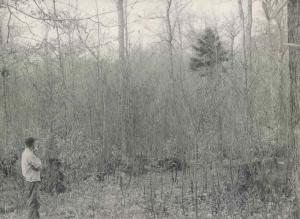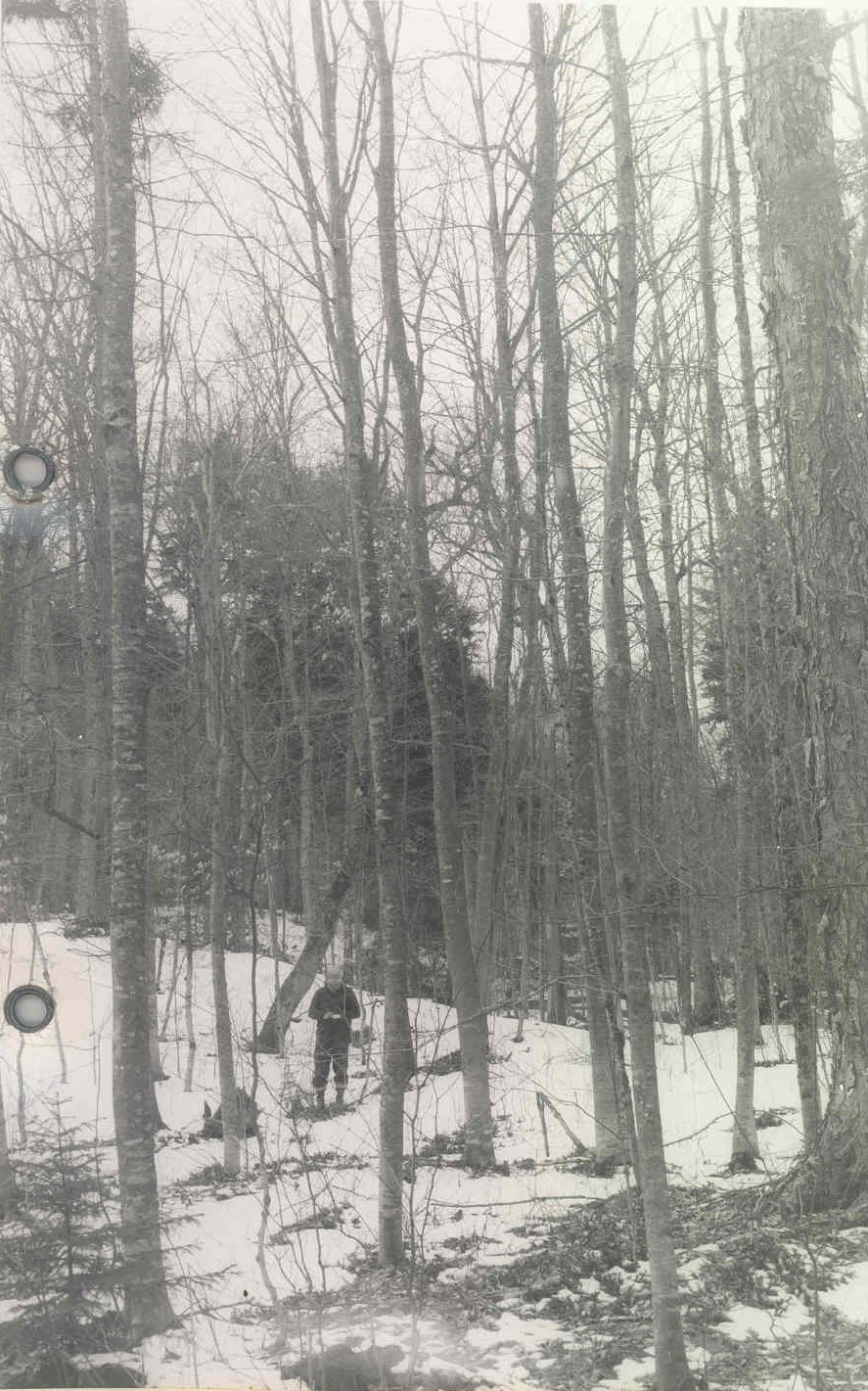| Collection: | Paul Smith Experimental Forest Historical Photo Archive |
| Keywords: |
personnel hardwood old growth |
| Organisms: |
yellow birch beech |
| Location: | Paul Smith Experimental Forest |
| Description: | The continuing decadence of yellow birch over 200 years old create openings favorable for beech and other tolerant hardwoods. |
| Date: | 1950 |
| Collection: | Paul Smith Experimental Forest Historical Photo Archive |
| Keywords: |
personnel hardwood |
| Organisms: |
beech yellow birch maple |
| Location: | Paul Smith Experimental Forest |
| Description: | A situation that is common in the Adirondacks: mature yellow birch and hard maple, with beech in a secondary position. In similar stands, cutting of the better hardwoods -- with only a limited market for beech -- has put beech in a dominant position. With the abundance of beech reproduction of all sizes, lack of hard maple of similar sizes, and the intolerance of the birch, it appears that beech can remain in possession of such sites for a long time. "Is this desirable or undesirable?" |
| Date: | 1950 |
| Collection: | Paul Smith Experimental Forest Historical Photo Archive |
| Keywords: | hardwood |
| Organisms: |
red maple balsam fir |
| Location: | Paul Smith Experimental Forest |
| Description: | On the Farm Woodlot poor-quality red maples were poisoned to release balsam fir. The maple at the left is riddled with heart rot. These red maples occupied this site for 40 years and most of them now prove to be unmerchantable because of extensive heartrot. "Have 40 years been wasted? Can we anticipate this and prevent it? Is it worth it?" |
| Date: | 1950 |
| Collection: | Paul Smith Experimental Forest Historical Photo Archive |
| Keywords: |
gap personnel hardwood reproduction |
| Organisms: |
maple beech |
| Location: | Paul Smith Experimental Forest |
| Description: | Large openings encouraged hard maple and beech reproduction. The large trees did not meet current standards of merchantability and were not wanted by the cutters 6 years earlier. Improving markets may permit harvest of some trees in the furture, but others are cull. "Can and should anything be done to help the better saplings? Would there be long-range benefits to compensate for investments made to improve the stand?" |
| Date: | 1950 |
| Collection: | Paul Smith Experimental Forest Historical Photo Archive |
| Keywords: |
selection post-harvest hardwood |
| Organisms: |
maple yellow birch white ash |
| Location: | Paul Smith Experimental Forest |
| Description: | With light selection cutting (residual stand 70 sq. ft. B.A.) existing understory beech were benefited, but few hard maple, white ash, and yellow birch seedlings grew more than 12 inches high. This is 17 years after the first cutting. "Does this happen only on less-fertile soils? Would hard maples have reacted like this on more-fertile soils? Maple seed trees were more abundant here than beech seed trees." |
| Date: | 1950 |
| Collection: | Paul Smith Experimental Forest Historical Photo Archive |
| Keywords: |
personnel stump hardwood pulpwood |
| Organisms: | maple |
| Location: | Paul Smith Experimental Forest |
| Description: | A hardwood stand "creamed" for sawlogs 6 years earlier. The stand is too far from existing hardwood pulpwood markets. "Can anything be done to rehabilitate the stand? Should only the cull trees be poisoned, assuming it could be done for less than $6.00 per acre? What would you do with it?" |
| Date: | 1950 |
| Collection: | Paul Smith Experimental Forest Historical Photo Archive |
| Keywords: | hardwood |
| Organisms: | maple |
| Location: | Paul Smith Experimental Forest |
| Description: | Poor-quality red maples 60-80 years old, and containing considerable heart rot, were poisoned to release softwoods. |
| Date: | 1950 |
| Collection: | Paul Smith Experimental Forest Historical Photo Archive |
| Keywords: |
personnel hardwood |
| Organisms: |
beech yellow birch maple |
| Location: | Paul Smith Experimental Forest |
| Description: | The natural area also contains stands of northern hardwoods. Here, beech have developed beneath large yellow birch and hard maple. |
| Date: | 1950 |
| Collection: | Paul Smith Experimental Forest Historical Photo Archive |
| Keywords: |
personnel hardwood |
| Organisms: | maple |
| Location: | Paul Smith Experimental Forest |
| Description: | There are some patches of hardwoods, but their quality was not very high. In more open places, understory hardwoods were more abundant. |
| Date: | 1950 |
| Collection: | Paul Smith Experimental Forest Historical Photo Archive |
| Keywords: |
hardwood pre-harvest |
| Organisms: | yellow birch |
| Location: | Paul Smith Experimental Forest |
| Description: | On some drier sites hardwoods dominated the overstory before cutting, but there were a few understory softwoods. |
| Date: | 1950 |
| Collection: | Paul Smith Experimental Forest Historical Photo Archive |
| Keywords: |
personnel hardwood old growth |
| Organisms: |
beech maple yellow birch |
| Location: | Paul Smith Experimental Forest |
| Description: | Mature norther hardwoods containing many intermediate beech. In this stand ages of mature trees averaged; hard maple 235, yellow birch 218, and beech 230. |
| Date: | 1950 |
| Collection: | Paul Smith Experimental Forest Historical Photo Archive |
| Keywords: |
regeneration hardwood post-harvest clearcut |
| Organisms: | yellow birch |
| Location: | Fernow area |
| Description: | Second growth northern hardwoods which followed a 100% clearcutting 50 years earlier. The Fernow area near Tupper Lake, N.Y. Area clearcut about 1900 to prepare it for a softwood planting which never was completed. |
| Date: | 1950 |
| Collection: | Paul Smith Experimental Forest Historical Photo Archive |
| Keywords: |
regeneration hardwood post-harvest clearcut |
| Organisms: | beech |
| Location: | Paul Smith Experimental Forest |
| Description: | Residual and second growth northern hardwoods on a "clearcutting". A large number of beech remain. |
| Date: | 1950 |
| Collection: | Paul Smith Experimental Forest Historical Photo Archive |
| Keywords: |
old growth hardwood |
| Organisms: | beech |
| Location: | Paul Smith Experimental Forest |
| Description: | The control plot was not disturbed. Beech saplings can grow even under this dense overstory, but there are fewer beech seedlings than occur on the selection plot. |
| Date: | 1950 |
| Collection: | Paul Smith Experimental Forest Historical Photo Archive |
| Keywords: |
selection hardwood |
| Organisms: |
maple beech |
| Location: | Paul Smith Experimental Forest |
| Description: | Selection plot. Only understory trees benefiting from these light cuttings were beech. In larger openings, some hard maple saplings developed. |
| Date: | 1950 |
| Collection: | Paul Smith Experimental Forest Historical Photo Archive |
| Keywords: |
personnel clearcut browse hardwood |
| Organisms: |
deer yellow birch white ash |
| Location: | Paul Smith Experimental Forest |
| Description: | Clearcut in 1937. Deer suppressed hardwoods until exclosure was put up 10 years later. With protection, white ash and yellow birch are growing; none this large are found outside the exclosure. |
| Date: | 1950 |
| Collection: | Paul Smith Experimental Forest Historical Photo Archive |
| Keywords: |
suppression hardwood |
| Organisms: |
maple beech yellow birch witch hobble white ash |
| Location: | Paul Smith Experimental Forest |
| Description: | Control plot. Under the dense hardwood overstory, few hard maple, yellow birch, or white ash seedlings developed beyond 12 inches high. Even the tolerant witch hobble and beech were much less abundant here than on the selection plot where they had more light. |
| Date: | 1950 |
| Collection: | Paul Smith Experimental Forest Historical Photo Archive |
| Keywords: |
pre-harvest hardwood personnel |
| Location: | Paul Smith Experimental Forest; Compartment 55 |
| Description: | Image taken at coordinates 73-22, direction N85W, distance 57 chains, with a bearing of S70E. |
| Date: | 1950 |
| Collection: | Paul Smith Experimental Forest Historical Photo Archive |
| Keywords: |
pre-harvest hardwood personnel |
| Organisms: | maple |
| Location: | Paul Smith Experimental Forest; Compartment 55 |
| Description: | Image taken at coordinates 72-22, direction N40E, distance 67 links; with a bearing of S55E. Mature hard maple in center of photo. |
| Date: | 1950 |
| Collection: | Paul Smith Experimental Forest Historical Photo Archive |
| Keywords: |
pre-harvest Hardwood personnel |
| Organisms: |
maple yellow birch beech spruce |
| Location: | Paul Smith Experimental Forest; Compartment 55 |
| Description: | Image taken at coordinates 70-22, direction N55W, distance 30 chains, with a bearing of S53E. Mature hard maple and yellow birch with sapling hard maple and beech understory. Suppressed spruce saplings. |
| Date: | 1950 |
| Collection: | Paul Smith Experimental Forest Historical Photo Archive |
| Keywords: |
pre-harvest hardwood personnel |
| Organisms: |
maple beech spruce |
| Location: | Paul Smith Experimental Forest; Compartment 55 |
| Description: | Image taken at coordinates 72-21, direction N52E, distance 40 links; with a bearing of S60E. Beech and hard maple saplings in half of photos. Overstory is hard maple and beech. Spruce is also scattered throughout this area as seen in the background. |
| Date: | 1950 |
| Collection: | Paul Smith Experimental Forest Historical Photo Archive |
| Keywords: |
pre-harvest hardwood personnel cruise |
| Organisms: |
maple yellow birch beech |
| Location: | Paul Smith Experimental Forest; Compartment 55 |
| Description: | Image taken at coordinates 73-21; direction S85E; distance 145ft; with a bearing of S48E. Hard maple and yellow birch with beech understory - many of the hardwoods that are to be cut as a result of treatment application, will be excellent growing stock quality. String in picture was used for 100% cruise. |
| Date: | 1950 |






















